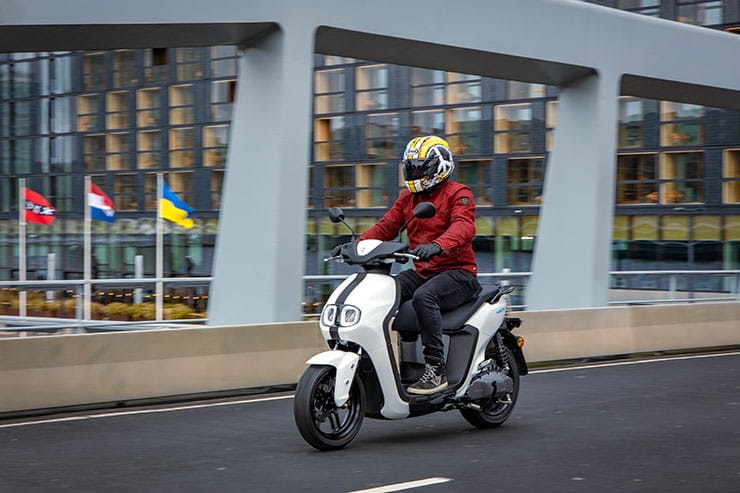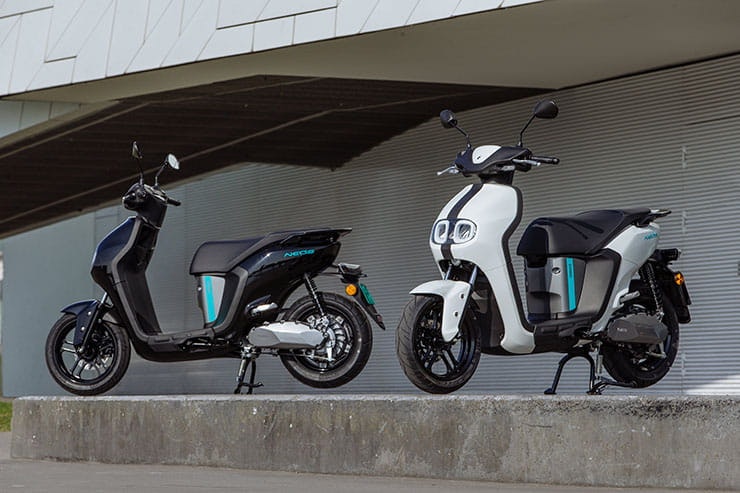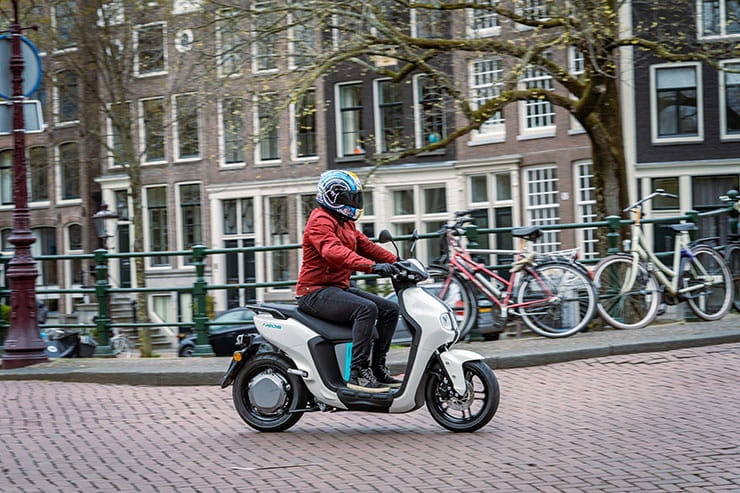Yamaha NEO’s – Review (2022 – on)
BikeSocial Road Tester
12.04.2022
Back in early March 2022, Yamaha entered a new era with Switch On, as the Japanese manufacturer unveiled its future in electric models. The all-new NEO’s is the first model to come from that range. The NEO’s is a 50cc equivalent AM licence scooter, with a top speed restricted to 44kph/27mph and a quoted 37km/23-mile range from its single, 8kg under-the-seat battery. At only £3005, the little Yamaha has been designed for inner-city commuting, which is why Yamaha sent Bennetts BikeSocial to Amsterdam, the home of electric mobility, to test the all-new electric scoot.
I remember when 50cc petrol scooters were everywhere. Over the years Yamaha has produced some excellent, almost iconic 50cc petrol-powered ’peds and scoots, but now they are rare – everyone is moving to electric. After all, electric scooters make sense, have comparative speed and weight to bikes powered by internal combustion engines, are easier to ride, cheaper to run, and competitively priced. Range is still limited and an issue, in this case a quoted 37km/23 miles on a single charge, but how far do you want to go on your 50cc equivalent scooter? And simply adding a second battery under the seat extends the range further.
Yamaha’s all-new scooter features under-seat storage, two riding modes, keyless ignition, connectivity, and large 13-inch wheels wrapped in decent Maxxis rubber. Top speed is a quoted 45kph/27mph, range a claimed 37km/23 mile, and a re-charge time of eight hours from a normal household plug (or four hours for a 20% to 80% charge). Bluetooth connectivity and a reassuringly good build quality for an attractive £3005, or just over £40 a month on PCP.
The Netherlands is the biggest market for electric-powered bikes (aka Urban Mobility, a phrase you will become familiar with over the coming years), which is why Yamaha sent us to Amsterdam to have silent but fun day of riding around this attractive and diverse city.
It’s good to see a major Japanese brand bringing an electric bike to the European market
Removable battery pack makes sense for indoor charging
It’s no heavier than an equivalent 50cc petrol moped
- Extra battery is £980
- No fast charger
- Real-world range is disappointing
Yamaha NEO’s (2022) Price
How much is the 2022 Yamaha NEO’s? £3005
What can you buy for £3005 or – more pertinently, after a deposit of £751 – for just £41.12 per month on PCP for 36 months? By my reckoning, just over £40 a month for a 50cc-equivalent, brand new electric scooter is pretty good value, especially when you consider that payment is equivalent to a modest round of drinks in London, or a Friday night takeaway for the family, or two tanks of fossil fuel for a normal motorcycle. A 16-year-old I know spends more than £40 a month on hair products.
But, attractive as the NEO’S price may be, there is even cheaper competition out there in electric scooterland. The Chinese-made Super Soco CUX is £2549, has the same (restricted) 45kph/28mph top speed, but a better quoted range of 40 miles. Piaggio has its own all-electric scooter with a 45km to 55km range priced at £2500 and, if you want old-school petrol, Aprilia still produces the attractive SXR four-stroke 50cc at £2400.
It's due into dealerships in May 2022 and is available in two colours; Milky White and Midnight Black.
PCP Representative Example
Yamaha NEO’s (2022) Power and Torque
The NEO’S air-cooled electric motor is housed inside the rear wheel and according to Yamaha delivers a massive 136Nm or 100ftlb of torque at just 50rpm, yes 50. Normal power is 2.3kw/3.1hp @ 424rpm, with a maximum output of 2.5kw/3.4hp @ 400rpm. As you can see, torque is instant.
Top speed is restricted to 45kph/28mph, because that is the law. An ‘ECO’ mode limits the top speed further to 38.5kph/24mph. Yes, that is low, but in some countries, riders as young as 14-years-old will be allowed to ride the NEO’S, while 30kph and 20mph limits are becoming all too familiar in Europe’s inner cities.
That said, Yamaha claims the new all-electric will out-drag its petrol-propelled predecessor, the four-stroke 50cc NEO’S 4, covering 100 metres in 10.9 seconds from a standing start compared to 12.16 seconds for the older scoot.
Performance
Traditionally, 50cc mopeds and scooters have been made faster by their young and eager owners. Yamaha’s legendary FS1-E in particular was responsive to a tune and would happily show an indicated 50mph, while the fun Yamaha two-stroke 50cc BWs could be tweaked – but this isn’t the case with the NEO’S. Its speed restriction means 45kph, or 28mph, is all you have. I did get a little giddy when I saw an indicated 47kph/29mph, but even after holding it flat, tucking in, legs on the rear pegs – that was it.
It's a slightly strange sensation, as acceleration over the first 50 meters is perky, with instant torque, and you can out-drag unsuspecting cars from the lights. So, while its speed is capped, this is a nippy little bike until it simply stops accelerating at an indicated 45-47kph, just below 30mph.
Unlike most electric bikes, there is no sound to the motor, you don’t hear it rev at all, so there is no real indication of speed aside from the speedo. On occasion, I was left muttering to myself, ‘Why have we stopped accelerating!’, before looking down and realising the NEO’S had hit the very soft speed limiter. The silent running is very impressive, by the way, but it does take a little getting used to.
ECO mode reduces the speed even further, and again the speed limiter is very soft: 38kph/25mph, and you’re done. In some cities this may prove useful, and it’s easy to flick between ECO and the standard mode to give an 8kph to 10kph boost.
In Amsterdam, built for bikes and life on two wheels, a top speed of just under 30mph was more than enough, but I’m unsure how it would fair in London, where the pace is a little higher. Yes, most of the inner city is restricted to 30mph or 20mph in places, but most don’t obey the limits like they do in Amsterdam.
Handling, Suspension, and Weight
The NEO’S is slightly more expensive than the Chinese equivalent competition, but this is where build quality and Yamaha know-how show. The ride quality from the KYB suspension is excellent for this type of bike. We are talking suspension with control, no matter what you throw at, including severe speed humps and kerb hops.
Furthermore, quality rubber from Maxxis should perform equally in the dry and wet. According to the MyRide Yamaha App, I managed 27 degrees of lean, yet nothing touched down, not even the side stand, and for a light, 98kg bike, it felt planted and more like a 125.
So the NEO’S is light, nimble and well put together – and that last feature is the key. With a silent-running bike, any imperfections like rattly bodywork or poor suspension are more apparent, but the Yamaha feels engineered and premium, like it has been put together by people who know what they are doing and how to set up a bike, unlike some of the competition.
The throttle is soft and not snatchy like some electric scoots, and the NEO’S is a doddle to ride, too, with a super-useful tight turning circle thrown in. Low speed balance is spot-on and it’s easy to crawl along at a walking pace with your feet on the roomy footboards.
Yamaha NEO’s (2022) Comfort and Economy
From a single battery, Yamaha claims 37km/23 miles in the standard riding mode, or 38.5km/24miles in ECO mode. Add the second battery (for £980) and the range increases to a claimed 68km/42 miles. When battery life drops to around 20% it automatically goes into Turtle mode, which restricts the power and speed, to hopefully get you home. On a single battery, you have around 30km/19 miles before you lose power.
Running two batteries, as our bike did on test, works well. You only run one battery at a time, and when battery one is about to go into Turtle mode, it automatically switches to battery two. You don’t have to stop and unplug anything. When the batteries switch, the rider is notified via the simple dash.
The range isn’t shown on the dash, just battery life via a bar-chart symbol. To check out your range you need to use the MyRide Yamaha app, which clearly shows the range of total battery in kilometres.
During road tests on slow bikes like this I usually ride slightly aggressively, testing acceleration, braking and handling and, after our 48.8km/30.3 miles ride, I still had 24.9km/15.5miles remaining, which gives a total range from two batteries of 73.7km/45.8miles – so not bad. Earlier in the day, after 21.6km/13.4 miles, I had 40.8km/30.9 miles remaining – a total range of 62.4km/38.8 miles and a little less than Yamaha’s claimed 68km/42mile. So you can see that real-world range depends on how (and where) you ride your NEO’S.
One battery is realistically going to last between 30 and 35km/18 and 22 miles to fully drained, while 60 to 70km/37 to 44 miles is my prediction for two batteries (though it will go into Turtle Mode at around 20%). Ride fast, throw in some hills or take a pillion, and that figure could drop to 25km/15 miles – which means you are going to need the second battery, which costs £980 and represents nearly a third of the original cost of the scooter itself.
But Yamaha labels this as an inner-city bike, a machine designed for nipping around town. It’s aimed especially at young riders dashing to school or college and back, or to part-time work, a few miles here and a few miles back, meaning 30km/18 miles should be enough for most, just.
There isn’t a fast charge option, and it takes eight hours to charge from 0% to 100%, which means overnight for most owners, while a 20 to 80% charge can be completed in four hours. If you opt for the second battery you will need a second charger, or to charge one battery, swap over and recharge the second battery. The batteries are easy to remove and only weigh 8kg – and can be charged from any normal household three-pin socket.
The riding position is roomy but be aware of the 795mm seat height, which is not tall by any means but higher than some of the competition.
Brakes
There’s no ABS on the NEO’s’ relatively simple braking setup, which features a single 200mm disc at the front and an old-school cable-operated shoe brake on the rear. The front set-up is more than adequate to stop a 100kg scooter from only 28mph, and thanks to the quality suspension, the forks hold their composure during heaving braking too. The simple set-up on the rear does the job, while I’m sure immature riders will appreciate the lack of ABS.
Rider Aids, Extra Equipment and Accessories
So, no ABS and, as you’d expect, no traction control either. There are two riding modes – the unfortunately acronymed ‘STD’, as well as ECO – but the ECO mode only adds a few kilometres to the battery range.
The Yamaha MyRide app is useful and worth downloading. It’s easy to connect to the bike and clearly shows the remaining range – a very useful tool. It will also show your lean angle, and you can trace your route should you want to share it with your mates. The simple dash will also highlight if you’ve received a text message.
There is a small open compartment to take a phone, with a 12v charger, and keyless ignition comes as standard. If you want a USB charger, this is an optional extra. Yamaha also offers bar and mirror mounts, plus a large 34-litre top case. And if you want that second battery, you will need to find a further £980.
Rivals
There aren’t many electric options from the major manufacturers but once you turn to Chinese-made machines there are a host of alternatives on the market.
Lexmoto offers several imported Yadea mopeds that with specs that come close to the NEO’s, while Super Soco’s CUX is another machine that has on-paper details very much like the Yamaha’s, including a removable battery. Niu’s range of electric mopeds – the NQi, MQi and UQi models – also look like convincing alternatives.
Most also claim longer ranges than the NEO’s, in the region of 40 to 55 miles between charges, despite being cheaper.
Super Soco CUX:
Power: 1.7bhp / 1.3kw rated / 3.8bhp / 2.8kw max
Torque: 36.9lbft / 50Nm
Weight: 74kg
Price: £2,459
NIU MQi GT EVO
Power: 8.8bhp / 6.5kw rated / 9.8bhp / 7.3kw max
Torque: 41.1ftlb / 56.2Nm
Weight: 128kg
Price: £4,099
Piaggio 1
Power: 1.6bhp / 1.2kw
Torque: 63ftlb / 85Nm
Weight: 85kg
Price: £2,500
Aprilia SXR 50
Power: 3.5bhp / 2.4kw @ 7000rpm
Torque: 2.4ftlb / 3.3Nm @ 6250rpm
Weight: 100kg (dry)
Price: £2,400
Yamaha NEO’s (2022) Verdict
As Yamaha enters a new era of electric models, this is an impressive start. The NEO’S is a quality 50cc-equivalent scooter that is hard to fault. The build quality is excellent, with no rattles and bangs, and its motor is perfectly silent like a magic carpet. The ride is controlled and noticeably supple for this type of bike, while the handling is easy and responsive, just like the brakes. The connectivity and ease of use of the MyRide app are a nice bonus while there is just about enough room under the seat for an open face lid (depending on if you’ve opted for one or two batteries) and the batteries are easy to access and simple to remove.
Now the downside; a sub-30mph top speed might not be enough for some, but to be fair, all scooters in this category suffer the same restriction. However, the battery range does differ among competitors, and the Yamaha’s is on the low side. When I was young, I wanted freedom and to ride everywhere, and I presume most young riders will feel the same. Will 30 to 35km be enough for an active teenager who wants to ride across town to get to college, meet friends for lunch, go out in the evening? Or will they have to fork out an extra £980 for the additional battery? Only time will tell.
Inner cities are becoming more congested, and petrol-driven vehicles are getting pushed out by congestion fees, less parking, and stricter speed limits. According to predicted sale figures, electric scooters are only going to gain in popularity, and the Yamaha NEO’S is one of the best. But will its range be enough?
Yamaha NEO’s (2022) Tech Spec
Looking for scooter or moped insurance? Get a quote for this machine with Bennetts moped and scooter insurance
What is MCIA Secured?
MCIA Secured gives bike buyers the chance to see just how much work a manufacturer has put into making their new investment as resistant to theft as possible.
As we all know, the more security you use, the less chance there is of your bike being stolen. In fact, based on research by Bennetts, using a disc lock makes your machine three times less likely to be stolen, while heavy duty kit can make it less likely to be stolen than a car. For reviews of the best security products, click here.
MCIA Secured gives motorcycles a rating out of five stars, based on the following being fitted to a new bike as standard:
A steering lock that meets the UNECE 62 standard
An ignition immobiliser system
A vehicle marking system
An alarm system
A vehicle tracking system with subscription
The higher the star rating, the better the security, so always ask your dealer what rating your bike has, and compare it to other machines on your shortlist.


